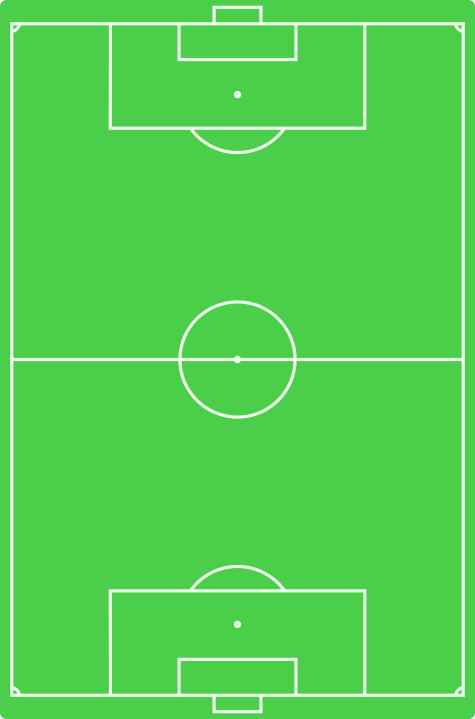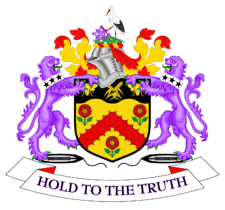Burnley F.C.
Burnley Football Club (/ˈbɜːrnli/) is an English association football club based in Burnley, Lancashire. Founded on 18 May 1882, it was one of the first to become professional (in 1883), and subsequently put pressure on The Football Association to permit payments to players. The club entered the FA Cup for the first time in 1885–86 and was one of the twelve founder members of the Football League in 1888–89. The team currently compete in the Premier League, the top tier of English football.
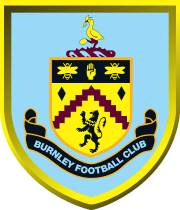 | ||||
| Full name | Burnley Football Club | |||
|---|---|---|---|---|
| Nickname(s) | The Clarets | |||
| Short name | BUR, BFC | |||
| Founded | 18 May 1882 | |||
| Ground | Turf Moor | |||
| Capacity | 21,944 | |||
| Chairman | Mike Garlick | |||
| Manager | Sean Dyche | |||
| League | Premier League | |||
| 2018–19 | Premier League, 15th of 20 | |||
| Website | Club website | |||
|
| ||||
Burnley have been champions of England twice, in 1920–21 and 1959–60, have won the FA Cup once, in 1913–14, and have won the FA Charity Shield twice, in 1960 and 1973. They have been runners-up in the First Division twice, in 1919–20 and 1961–62, and FA Cup runners-up twice, in 1946–47 and 1961–62. The team also reached the quarter-finals of the 1960–61 European Cup. Burnley are one of only five sides to have won all four professional divisions of English football, along with Wolverhampton Wanderers, Preston North End, Sheffield United and Portsmouth.
The team have played home games at Turf Moor since February 1883, after they had moved from their original premises at Calder Vale. The club colours of claret and blue were adopted before the 1910–11 season in tribute to the then Football League champions, Aston Villa; they are today nicknamed "the Clarets", due to the dominant colour of the home shirts. Burnley's current emblem is based on the town's coat of arms. The team have a long-standing rivalry with nearby club Blackburn Rovers, with whom they contest the East Lancashire Derby.
History
Early beginnings and glory either side of the First World War (1882–1946)

The club was founded on 18 May 1882 by members of Burnley Rovers Rugby Club, who voted for a shift from rugby union to association football, as more income could be generated by playing the latter code.[1] The suffix "Rovers" was dropped a short time later.[2] The team played their first-ever match on 10 August against local side Burnley Wanderers and won 4–0.[3] In February 1883, the club was invited by Burnley Cricket Club to move to a pitch adjacent to the cricket field at Turf Moor.[4] That same year saw them win their first silverware; the Dr Dean Trophy, a knockout competition between amateur clubs in the Burnley area.[5]
By the end of 1883, the club turned professional and signed many Scottish players, who were regarded as the best footballers.[6] As a result, Burnley refused to join The Football Association (FA) and its FA Cup, since the association refused to allow professional players.[7] In 1884, they led a group of 35 other clubs in the formation of a breakaway, the British Football Association, to challenge the supremacy of the FA.[7][8] This threat of secession led to the permission of professionalism by an FA rule change in July 1885, which made the new body redundant.[8]
Burnley made their first appearance in the FA Cup in 1885–86; however, most professionals were prohibited entry due to rules of the FA that year,[lower-alpha 1] so their reserve side were fielded and lost 11–0 to Darwen Old Wanderers.[10] In October 1886, Turf Moor became the first professional ground to be visited by a member of the Royal Family, when Prince Albert Victor attended a match between Burnley and Bolton Wanderers.[5][11] The club was among the twelve founders of the Football League in 1888–89 and one of the six based in Lancashire.[12] Burnley's William Tait became the first player to score a hat-trick in league football in the second match.[13] In 1889–90, they won their first Lancashire Cup, after local rivals Blackburn Rovers were beaten in the final.[14] Nicknames at this point were "Turfites", "Moorites" or "Royalites", as a result of their ground's name and the royal connection.[15]
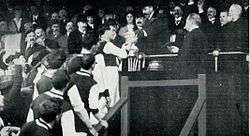
Burnley were relegated to the Second Division for the first time in 1896–97.[16] The team won the division the next season; only two of 30 matches were lost before promotion was gained through a series of test matches.[17] They were relegated again in 1899–1900 and found themselves at the centre of controversy when their goalkeeper, Jack Hillman, attempted to bribe opponents Nottingham Forest in the last match of the season. It was the earliest recorded case of match fixing in football.[18] The side continued to play in the Second Division and even finished in bottom place in 1902–03 (but were re-elected).[19] Harry Windle was elected chairman in 1909, after which the club's finances turned around.[20] He appointed manager John Haworth in 1910,[21] who changed the club's colours from green to the claret and blue of Aston Villa, the then Football League champions, as Haworth and the Burnley committee believed it might bring a change of fortune.[22] In 1912–13, they won promotion to the First Division and reached the FA Cup semi-final. Burnley won their first major honour the following year, after Liverpool were defeated in the FA Cup Final.[23]
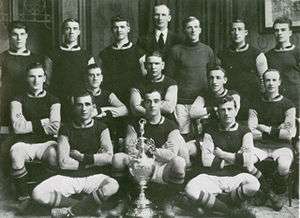
The team finished second to West Bromwich Albion in 1919–20,[24] before winning their first ever First Division championship in 1920–21.[25] Burnley lost the opening three games, but went unbeaten in the following 30 league matches, a then English record.[26][27] The death of Haworth in 1924 was followed by a steady deterioration of their position, which culminated in demotion in 1929–30.[28] They struggled in the second tier and narrowly avoided a further relegation in 1931–32 by two points.[29][30] The years through to the outbreak of the Second World War were characterised by uninspiring league finishes.[29]
Golden, progressive era under Bob Lord, Alan Brown and Harry Potts (1946–1976)
In the first season of post-war league football, Burnley gained promotion through second place and reached the FA Cup Final, but were defeated by Charlton Athletic after extra time.[31] The team's defence was nicknamed "The Iron Curtain", since they only conceded 29 goals in 42 league matches.[32] Burnley finished third in their first season back in the top flight, as they began to assemble a squad capable of regularly aiming for honours.[33][34]
Alan Brown was appointed manager in 1954,[35] and Bob Lord chairman a year later.[36] The club became one of the most progressive around under their tenures.[37][38] Burnley were one of the first to build a purpose-built training centre (Gawthorpe),[36][39] and they became renowned for their youth policy and scouting system, which yielded many young players over the years.[40] Brown also introduced short corners and free kick routines.[41][42] In 1958, former Burnley player Harry Potts was appointed manager.[43] His team mainly revolved around the duo of captain Jimmy Adamson and playmaker Jimmy McIlroy.[44] Potts often employed the, at the time unfashionable, 4–4–2 formation and he introduced Total Football to English football.[36][43]
Burnley clinched a second First Division title in 1959–60. They had not topped the table until the last match was played out.[45] The squad cost only £13,000 (equivalent to £300,000 in 2020)[lower-alpha 2] in transfer fees — £8,000 on McIlroy in 1950 and £5,000 on left-back Alex Elder in 1959.[46] The other players all came from their youth academy.[47] The town of Burnley became the smallest to have an English first tier champion, since it counted 80,000 inhabitants.[48] After the season finished, they went to the United States to participate in the International Soccer League, the inaugural international football tournament in North America.[49]
The following season, Burnley played in European competition for the first time, in the European Cup. They defeated former finalists Stade de Reims in the first round, but went out against Hamburger SV in the quarter-finals.[50] The team finished the 1961–62 season as runners-up (after only two of the last thirteen league matches were won) to newly promoted Ipswich Town, and had a run to the FA Cup Final, but lost against Tottenham Hotspur.[51] Adamson was named FWA Footballer of the Year, with McIlroy as runner-up.[52]
Nonetheless, although far from a two-man team, the controversial departure of McIlroy to Stoke City (1963) and retirement of Adamson (1964) coincided with a decline in fortunes.[53] Even more damaging was the impact of the abolition of the maximum wage in 1961, which meant clubs from small towns, like Burnley, could no longer compete financially with sides from bigger towns and cities.[36][54] The team managed, however, to retain a First Division place throughout the decade, and even finished third in 1965–66 to qualify for the 1966–67 Inter-Cities Fairs Cup.[16]
Potts was replaced by Adamson as manager in 1970 after a 12-year spell,[55] but he was unable to halt the slide as relegation followed in 1970–71.[56] Burnley won the Second Division title in 1972–73,[57] and were as a result invited to play in the 1973 FA Charity Shield, where they emerged as winners against Manchester City.[58] In 1975, the team were victims of one of the great FA Cup shocks of all time when Wimbledon, then in the Southern League, won 1–0 at Turf Moor.[59] Adamson left the club in January 1976, and relegation from the First Division followed later that year.[60][61] In ensuing seasons, a decline in home attendances combined with a enlarged debt forced Burnley to sell their best players, which caused a rapid fall through the divisions.[62]
Near oblivion and recovery (1976–2009)

The team were relegated to the Third Division for the first time in 1979–80.[16] Under the management of former Burnley player Brian Miller,[63] they returned to the second tier as champions in 1981–82.[64] However, this return was short-lived and lasted only one year.[65] Managerial changes continued to be made in search for success; Miller was replaced by Frank Casper in early 1983, he by John Bond before the 1983–84 season and Bond himself by John Benson a season later.[66] The unpopular Bond was the first manager since Frank Hill (1948–1954) without a previous playing career at the club. He was criticised for the signing of expensive players, which increased Burnley's debt, and for the sale of young talents Lee Dixon, Brian Laws and Trevor Steven.[67] Benson was in charge when Burnley were relegated to the Fourth Division for the first time at the end of the 1984–85 season.[16]
The team avoided relegation to the Football Conference on the last day in 1986–87, after they won against Orient and their rivals drew or lost.[68] The board had attempted to purchase almost bankrupt Welsh club Cardiff City and relocate it to Turf Moor, if they were relegated, in what would have been the Football League's first franchise operation.[69]

In 1988, Burnley played Wolverhampton Wanderers in the final of the Associate Members' Cup, but lost 2–0. The match was attended by 80,000 people, a record for a tie between two sides from the fourth tier.[70] The team won the Fourth Division in 1991–92 under manager Jimmy Mullen. He succeeded Frank Casper in October 1991 and won his first nine league matches in charge.[71] Furthermore, the Clarets became only the second club to win all four professional divisions of English football, after Wolves.[72] In 1993–94, Burnley won the Second Division play-offs and gained promotion to the second tier.[73] Relegation followed after one season,[74] and in 1997–98 only a last day victory over Plymouth Argyle ensured a narrow escape from relegation back into the fourth tier.[75] Chris Waddle was player-manager that season and Glenn Roeder his assistant,[76] but their departures and the appointment of Stan Ternent that summer saw the club start to make further progress.[77] In 1999–2000, they finished second and were promoted to the second tier.[78]
Burnley immediately made an impact, as during the 2000–01 and 2001–02 seasons, they emerged as serious contenders for a promotion play-off place.[16] In early 2002, financial problems caused by the collapse of ITV Digital brought the club again close to administration.[79][80] Ternent was sacked in 2004, after he narrowly avoided relegation with a squad composed of many loanees and some players who were not entirely fit.[81][82] Steve Cotterill was then appointed as manager,[83] but was replaced in November 2007 by Owen Coyle.[84] The 2008–09 season, Coyle's first full season in charge, ended with promotion to the Premier League. Sheffield United were defeated in the Championship play-off Final; a return to the top flight after 33 years.[85] Furthermore, Burnley reached the semi-final of the League Cup for the first time in over 25 years,[86] but were beaten on aggregate by Tottenham in the last minutes of the second leg.[87]
Premier League promotions, relegations and back in Europe (2009–present)
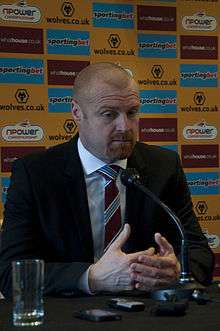
Promotion made the town of Burnley the smallest to host a Premier League club, since the rebranding of the league divisions in 1992.[88][89] They started the season well and became the first newly promoted team in the Premier League to win their first four league home games.[90] However, Coyle left the club in January 2010 to manage local rivals Bolton Wanderers.[91] He was replaced by Brian Laws, but the team's form plummeted and were relegated after a single season.[92] Laws was dismissed in December 2010 and replaced by Eddie Howe,[93] who was succeeded by Sean Dyche in October 2012.[94]
In his first full season in charge, Dyche guided Burnley back to the Premier League in 2013–14 on a tight budget and with a small squad.[95] The team went down after one season,[96] but won the Championship title on their return in 2015–16, in which they equaled their club record of 93 points of 2013–14, and ended the season with a run of 23 league games undefeated.[97] The side stayed up this time; the 2016–17 season was concluded in 16th place.[98] Burnley finished seventh in 2017–18 to qualify for the 2018–19 UEFA Europa League,[99] in which they were eliminated in the play-off round by Greek club Olympiacos.[100]
Players
First-team squad
- As of 28 June 2020[101]
Note: Flags indicate national team as defined under FIFA eligibility rules. Players may hold more than one non-FIFA nationality.
|
|
Out on loan
Note: Flags indicate national team as defined under FIFA eligibility rules. Players may hold more than one non-FIFA nationality.
|
Under-23s and Academy
Management
Football management
| Position | Name |
|---|---|
| Manager | |
| Assistant manager | |
| First team coach | |
| Goalkeeping coach | |
| Head physiotherapist | |
| Head of sports science |
Source:[101]
Board of directors
| Position | Name |
|---|---|
| Chairman | Michael Garlick |
| Vice-chairman | Barry Kilby |
| Chief executive | Neil Hart |
| Members | Clive Holt John Banaskiewicz Brian Nelson Terry Crabb Brendan Flood |
Source:[102]
Owners
Burnley is one of the few clubs in the Premier League that is British-owned.[103] Every director at the club is locally born or based, and receives no wages. As of 2019–20, Burnley is debt-free.[104] Chairman Mike Garlick holds 49.24% of outstanding shares of the club and member of the board of directors John Banaszkiewicz another 28.2%. The other five members of the board hold, between them, a total of 16.36%. The total holding of shares by all board members amounts to 93.8%.[102]
Chairmen
The following have been chairman of the club's board of directors:[105]
| Period | Name |
|---|---|
| 1882–83 | Albert Jobling |
| 1883–1885 | John Rawcliffe |
| 1885–1887 | John Bradley |
| 1887–1896 | Wyatt Granger |
| 1896–1899 | Charles Sutcliffe |
| 1899–1909 | Edwin Whitehead |
| 1909–1930 | Harry Windle |
| 1930–1932 | William Bracewell |
| 1932–1934 | Edward Tate |
| 1934–1948 | Tom Clegg |
| 1948–1952 | Ernest Kay |
| 1952–1955 | Wilfred Hopkinson |
| 1955–1981 | Bob Lord |
| 1981–1985 | John Jackson |
| 1985–1998 | Frank Teasdale |
| 1998–2012 | Barry Kilby |
| 2012–2015 | John Banaszkiewicz Mike Garlick[106] |
| 2015– | Mike Garlick[107] |
Notable former players and managers
Players
Burnley have been represented by numerous high-profile players over the years, most notably Jimmy McIlroy and Jimmy Adamson. The latter won the FWA Footballer of the Year award in 1962, the first and to date only time a Clarets player achieved this.[108] Four years later, youth graduate Willie Irvine became the First Division top goal scorer, also a unique feat in the club's history.[109] Welshman Leighton James is the only Burnley player to have been included in the PFA Team of the Year whilst in the first tier, when he was selected as a member of the 1974–75 squad.[110] In total, 29 players have won full England caps during their time with the Clarets; Bob Kelly won the most caps (11) and scored the most goals (6).[111][112]
The English Football Hall of Fame currently contains five former Burnley players: Tommy Lawton, Jimmy McIlroy, Mike Summerbee, Ian Wright and Paul Gascoigne.[113] The latter three had, however, relatively short spells at the club and were at the end of their playing careers.[114] Two of these five players, Lawton and McIlroy, also featured in a list entitled "The Football League 100 Legends", as Burnley's only representatives.[115] The list was released by the Football League in 1998, to celebrate the 100th season of league football. McIlroy was voted as the club's PFA Fans' Favourite in 2007.[116]
In 2017, pictures of 31 "Clarets' legends" from different eras in its history were hung beside the turnstiles of Turf Moor.[117] The players were picked by the fans via an online vote. It was a cooperation between the club and members of the Burnley supporters' clubs, to "improve the appearance of the ground and provide a vivid history of some of the greatest players to wear a claret and blue shirt".[117] The Clarets' first international, John Yates, was omitted as no suitable image of him could be found. He was replaced by George Halley. Including Yates, the following 32 players were picked:[118][119]
Player of the Year Award

The following have been voted Player of the Year by the club's supporters:
Managers
The following table contains the managers who have all won at least one (major or minor) trophy when in charge of Burnley:[85][97][136]
| Name | Nationality | From | To | Played | Won | Drew | Lost | Win%[lower-alpha 3] | Honours |
|---|---|---|---|---|---|---|---|---|---|
| Harry Bradshaw | August 1894 | June 1899 | 164 | 65 | 37 | 62 | 39.63 | Second Division champions: 1897–98 | |
| John Haworth | July 1910 | December 1924 | 464 | 203 | 106 | 155 | 43.75 | FA Cup winners: 1913–14 First Division champions: 1920–21 | |
| Harry Potts | February 1958 | February 1970 | 605 | 272 | 141 | 192 | 44.96 | First Division champions: 1959–60 FA Charity Shield winners (shared): 1960 | |
| Jimmy Adamson | February 1970 | January 1976 | 272 | 104 | 74 | 94 | 38.24 | Second Division champions: 1972–73 FA Charity Shield winners: 1973 | |
| Harry Potts (2) | February 1977 | October 1979 | 123 | 42 | 32 | 49 | 34.15 | Anglo–Scottish Cup winners: 1978–79 | |
| Brian Miller | October 1979 | January 1983 | 166 | 57 | 50 | 59 | 34.34 | Third Division champions: 1981–82 | |
| Jimmy Mullen | October 1991 | February 1996 | 249 | 97 | 67 | 85 | 38.96 | Fourth Division champions: 1991–92 Second Division play–off winners: 1993–94 | |
| Owen Coyle | November 2007 | January 2010 | 116 | 49 | 29 | 38 | 42.24 | Championship play–off winners: 2008–09 | |
| Sean Dyche | October 2012 | 340 | 129 | 91 | 120 | 37.94 | Championship champions: 2015–16 |
Club identity
Kits and colours
In the early years, various kit designs and colours were used by Burnley. Throughout the first nine years these were various permutations of blue and white, the colours of the club's forerunners Burnley Rovers Rugby Club.[137] After two years of claret and amber stripes with black shorts, for much of the 1890s a combination of black with yellow stripes was used, although the team wore a shirt with pink and white stripes during the 1894–95 season. Between 1897 and 1900 the club used a plain red shirt and from 1900 until 1910 it changed to an all green shirt with white shorts.[137] In 1910, Burnley changed their colours to claret and sky blue, the colours that they now have had for the majority of their history, save for a spell in white shirts and black shorts during the 1930s.[138] The adoption of the claret and sky blue colour combination was a homage to league champions Aston Villa, who wore those colours. The club's committee and manager John Haworth believed it might bring a change of fortune.[22] Burnley's away kit for the 2006–07 season, a yellow shirt with claret bar, yellow shorts and yellow socks, won the "Best Kit Design" award at the Football League Awards.[139]
Kit suppliers and shirt sponsors
| Period | Kit manufacturer | Shirt sponsor (chest) | Shirt sponsor (sleeve) |
|---|---|---|---|
| 1975–1981 | Umbro | — | — |
| 1981–82 | Spall | ||
| 1982–83 | POCO | ||
| 1983–84 | TSB | ||
| 1984–1987 | Multipart | ||
| 1987–88 | En-s | ||
| 1988–89 | Spall | Endsleigh | |
| 1989–1991 | Ellgren | ||
| 1991–1993 | Ribero | ||
| 1993–1996 | Mitre | ||
| 1996–1998 | Adidas | ||
| 1998–99 | P3 Computers | ||
| 1999–2000 | Super League | ||
| 2000–01 | — | ||
| 2001–02 | Lanway | ||
| 2002–2004 | TFG Sports | ||
| 2004–05 | Hunters | ||
| 2005–2007 | Erreà | ||
| 2007–2009 | Holland's | ||
| 2009–10 | Cooke | ||
| 2010–2012 | Puma | Fun88 | |
| 2012–2014 | Premier Range | ||
| 2014–15 | Fun88 | ||
| 2015–16 | Oak Furniture Land | ||
| 2016–17 | Dafabet | ||
| 2017–18 | Golf Clash[140] | ||
| 2018–19 | LaBa360 | AstroPay[141] | |
| 2019–present | Umbro[142] | LoveBet[143] | |
Source:[138]
Crest
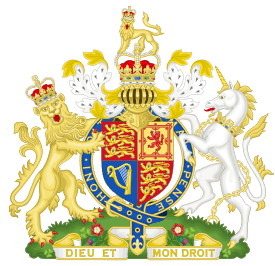
The Clarets' first recorded usage of a crest was in December 1887, when they wore the Royal Arms on the shirt.[138] Prince Albert Victor had visited Turf Moor in October 1886 when Burnley played Bolton Wanderers — the first visit to a professional football ground by a member of the Royal Family.[11] To commemorate the visit, the club received a set of white jerseys featured with a blue sash and embellished with the Royal coat of arms.[138] The team would regularly wear the Royal crest until 1895, when it disappeared from the shirts.[144] When they played the 1914 FA Cup Final watched by King George V, the Royal Arms featured once again on the kits.[145]
From 1914, the team played in unadorned shirts, albeit the coat of arms of Burnley was worn in the FA Cup semi-final in 1935 and the 1947 FA Cup Final.[138][146] Burnley won the First Division for a second time in 1960, and were as a result allowed to wear the town's crest on their shirts for an indefinite period of time.[138] The town's coat of arms was worn until 1969, when it was replaced with the vertical monogram "BFC". In 1975, the initials were placed horizontally and were lettered with gold. The club used a new designed badge from 1979, before it returned to the horizontal version of the "BFC" monogram in 1983, which was lettered in white this time. In 1987, Burnley returned to the crest used from 1979 to 1983.[138]
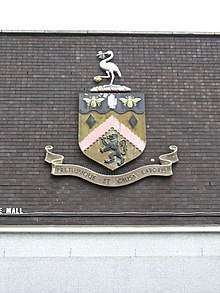
The latest major change came in 2009. To celebrate the 50th anniversary of the 1959–60 First Division title win, Burnley decided to return to the crest used from 1960 to 1969.[138] The following season, the Latin motto "Pretiumque et Causa Laboris" (English: "The prize and the cause of [our] labour") was replaced with the inscription "Burnley Football Club".[138][147]
The club's current badge is based on the town's coat of arms.[148] The stork at the top of the crest refers to the Starkie family, who were prominent in the rural Burnley area. In its mouth it holds the Lacy knot, the badge of the de Lacy family, who held Burnley and Blackburnshire in medieval times. The stork stands on a hill (the Pennines) and cotton plants — which represents the cotton making heritage of the town. In the black band, the hand represents Burnley's motto, "Hold to the Truth", derived from the Towneley family. The two bees refer to the town's "busy ambience" and the saying "as busy as a bee", but also allude to the demolished Bee Hole End at Turf Moor. Beneath, the wavy, claret-coloured line is a reference to the River Brun, which runs through the settlement. The lion represents royalty, as the club was visited by Prince Albert Victor in 1886.[148]
Stadium
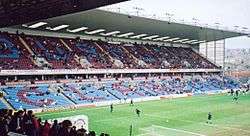
The team have played their home games at Turf Moor since February 1883, which replaced their original premises at Calder Vale.[149] The Turf Moor site was first used for sport in 1833, when Burnley Cricket Club was established.[4] In February 1883, they invited Burnley Football Club to move to a pitch adjacent to the cricket field.[4] Both clubs have remained there since, and only Lancashire rivals Preston North End have continuously occupied the same stadium (Deepdale) for longer.[150]
The ground originally consisted of just a pitch and the first grandstand was not built until 1885.[4] In 1888, the first league match at Turf Moor was an encounter against Bolton Wanderers. Burnley emerged as 4–1 winners, and Fred Poland netted the first league goal at the stadium.[151] At the time of the First World War, Turf Moor's capacity was increased from 20,000 to 50,000 under chairman Harry Windle, partly funded by the club's 1914 FA Cup win.[152] The ground hosted its only FA Cup semi-final in 1922, between Huddersfield Town and Notts County, and five years later it hosted its only senior international match, between England and Wales for the British Home Championship.[153] From the end of the Second World War until the mid-1960s, crowds in the stadium averaged in the 20,000–35,000 range, and Burnley averaged a club-record attendance of 33,621 in the First Division in 1947–48.[154] The record attendance for a single match was already set in 1924 against Huddersfield Town in a third round FA Cup tie, when 54,755 spectators attended.[155] In 1960, in a fifth round FA Cup replay against Bradford City, there was an official reported attendance of 52,850. Some of the gates were, however, broken down and many uncounted fans poured into the ground. Many supporters were also locked out, and the road from Bradford over the Moss at Colne had to be closed to traffic.[156]
The stadium consists of four stands; the James Hargreaves Stand (formerly the Longside), the Jimmy McIlroy Stand (formerly the Bee Hole End), the Bob Lord Stand, and the Cricket Field Stand for home and away fans.[149][157] The current capacity is 21,944 all-seated.[158] Turf Moor had a slight slope in the field until 1974, when the pitch was raised and a new drainage system was installed to remove it.[149] During the mid-1990s, the ground underwent further refurbishment when the Longside and Bee Hole End terraces were replaced by all-seater stands as a result of the Taylor Report, which reduced the capacity in the progress.[159]
Supporters and rivalries
Supporters
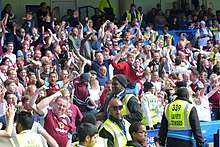
Supporters of Burnley are traditionally drawn from East Lancashire and West Yorkshire.[160] Furthermore, the club is one of the best supported sides in English football per head of population,[161] with average attendances of 20,000 in the Premier League in a town of approximately 73,000 inhabitants.[162][163] When the team won the 1959–60 First Division, the fan-ratio was almost thrice the top flight average, as Turf Moor had an average home attendance of 26,869 and the town counted about 80,000 residents; a ratio of about 34 per cent.[164] Besides a loyal, local fan base,[165] it also has numerous supporters' clubs across the United Kingdom,[166] and overseas, with supporters' clubs in Australia, Finland, Mauritius, Poland, Thailand, and United States amongst others.[167] The club's supporters have a long-standing supporters' friendship with Dutch team Helmond Sport since 1995. Burnley and Helmond have a small following who regularly make an overseas journey to visit each other's matches.[168] A frequently sung chant since the early 1970s is "No Nay Never", an adaptation of the traditional song "Wild Rover", which has lyrics to offend main rivals Blackburn Rovers.[169]
As a result of the fall to the lower leagues and the simultaneously enlarged presence of hooliganism in English football in the 1980s, a hooligan firm linked to Burnley was established. It was called the "Suicide Squad" and became infamous for violent clashes with many other firms and fans in the country.[170] They also featured in the television documentary series The Real Football Factories presented by Danny Dyer.[171] Twelve members were sentenced to jail for a total of 32 years in 2011, after a high-profile incident with supporters of Blackburn Rovers in 2009.[172]
In 2019, Clarets fan Scott Cunliffe was honoured by the UEFA with the #EqualGame Award "for his work as role model highlighting diversity, inclusion and accessibility in football".[173] During the 2018–19 campaign he ran to every single away match, as he covered more than 3,000 miles.[174] It was labelled the "RunAway Challenge" and he raised more than £50,000 for Premier League clubs' community trusts and local charities in Burnley.[175] Notable fans over the years have included football pioneer Jimmy Hogan, who was a regular attendee at Turf Moor,[176] journalist Alastair Campbell, who has been regularly involved in events with the club,[177] and cricketer James Anderson, who also worked in Burnley's ticket office on a part-time basis.[178]
A popular drink served at home matches since the First World War is "Béné & Hot" — the French liqueur Bénédictine topped up with hot water.[179] This is as a result of Great War soldiers of the East Lancashire Regiment, who acquired a taste for the drink whilst stationed in France. The soldiers drank it with hot water to keep warm in the trenches, and the surviving soldiers later returned to the East Lancashire area with the liqueur.[179] In excess of 30 bottles are sold at each home game, which makes the club one of the world's biggest sellers of the liqueur, and Turf Moor is the only British football ground to sell it.[179]
Rivalries
Burnley's main rivals are Blackburn Rovers, with whom they contest the East Lancashire Derby, named after the region both clubs hail from. Games between these sides from former mill towns are also known under the name "Cotton Mills derby", although not as common.[180][181] Both are founder members of the Football League and have won the First Division and the FA Cup.[180][182] The two clubs are separated by only 14 miles and besides the geographical proximity,[181] they have a long-standing history of fierce rivalry too; the first competitive clash was a Football League match in 1888.[183] Four years earlier, however, they had met for the first time in a friendly, with considerable pride at stake.[184][185] Burnley hold the slightly better head-to-head record, as the Clarets have won 49 games to Blackburn's 45, pre-league matches included.[183][184] The team's closest geographic rival are actually Accrington Stanley, but as they have never competed at the same level (although defunct club Accrington did), there is no significant rivalry between both.[186]
Other rivalries exist with local clubs Blackpool, Bolton Wanderers and Preston North End.[187] They have regularly played them in the league and cup competitions and the encounter between Burnley and Preston is, as of 2019–20, the most frequently played match in both club's histories.[188][189] When in the same tier, Burnley stage a Roses rivalry with nearby West Yorkshire sides Bradford City and Leeds United.[190][191] The Clarets also contested heated matches with Halifax Town, Plymouth Argyle, Rochdale and Stockport County in the 1990s, when they played in the lower leagues, although feelings of animosity were mainly one-sided.[187]
Honours and achievements
League
Burnley are one of only five teams (and were the second) to have won all four professional divisions of English football, along with Wolverhampton Wanderers, Preston North End, Sheffield United and Portsmouth.[72] The club's honours include the following:[16][192]
First Division (Tier 1)[lower-alpha 4]
Second Division/Championship (Tier 2)
- Winners (3): 1897–98, 1972–73, 2015–16
- Promoted (3): 1912–13, 1946–47, 2013–14
- Play–off winners (1): 2008–09
Third Division/Second Division (Tier 3)
Fourth Division (Tier 4)
- Winners (1): 1991–92
Regional
Lancashire Cup (nowadays for reserve teams)[196]
- Winners (12): 1889–90, 1914–15, 1949–50, 1951–52, 1959–60, 1960–61, 1961–62, 1964–65, 1965–66, 1969–70, 1971–72, 1992–93
Records
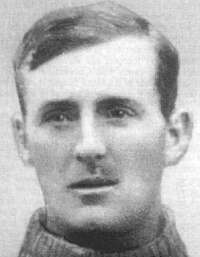
The record for the most appearances in all competitions for Burnley is held by goalkeeper and one-club man Jerry Dawson, who made 569 first team appearances between 1907 and 1928.[197] The club's top goal scorer is George Beel, who scored 188 goals from 1923 to 1932.[198] He also holds the record for the most league goals scored in a season, 35, in the 1927–28 First Division season.[29] Jimmy Robson and Willie Irvine have both scored the most goals (37) in competitive matches in a single season. In 1960–61, Robson scored 25 goals in the First Division, five in the FA Cup, four in the League Cup, and three in the European Cup.[199] Irvine scored 29 goals in the First Division, five in the FA Cup, and three in the League Cup in 1965–66.[200] Jimmy McIlroy is the most capped player whilst at the club, as he made 51 appearances for Northern Ireland between 1951 and 1962.[111] The first Burnley player to play in an international match was John Yates, who took to the field for England against Ireland in March 1889. He scored a hat-trick, but despite this, he was never called up again.[201]
The club's largest win in league football was a 9–0 victory over Darwen in the First Division in 1891–92.[202] Burnley's largest victories in the FA Cup have been 9–0 wins over Crystal Palace (1908–09), New Brighton (1956–57) and Penrith (1984–85).[202] The largest defeat is an 11–0 loss to Darwen Old Wanderers in the FA Cup first round in the 1885–86 season, when Burnley fielded their reserve side, as most professionals were prohibited entry due to rules of the FA that year.[10]
The club's record home attendance is 54,775 for a third round FA Cup match against Huddersfield Town in February 1924.[155] Burnley averaged a club-record attendance of 33,621 in the 1947–48 First Division season.[154] The team's longest unbeaten run in the league was between 6 September 1920 and 25 March 1921, to which they remained unbeaten for 30 games on their way to the First Division title. It stood as the longest stretch without defeat in a single English professional league season until Arsenal bettered it in 2003–04.[27]
The highest transfer fee received is £25 million, from Everton for defender Michael Keane in 2017,[203] while the highest transfer fee paid by the club was both for forward Chris Wood from Leeds United in 2017 and for defender Ben Gibson from Middlesbrough in 2018. The pair were reported to be bought for a fee of £15 million each.[204] Forward Bob Kelly broke the world transfer record in 1925, when he moved from Burnley to Sunderland for £6,550 — equivalent to £380,000 in 2020.[205][lower-alpha 2]
In media and popular culture
A number of films and television programmes have included references to Burnley over the past few decades. The club's supporters briefly appear in the 1965 Beatles feature film Help!, where footage of a crowd scene from the 1962 FA Cup Final against Tottenham Hotspur is used.[206] The music video of the single "Kicker Conspiracy" from post-punk band The Fall was shot at Turf Moor in 1983.[207] Scottish actor Colin Buchanan occasionally wore a Burnley shirt on the comedy drama series All Quiet on the Preston Front.[208] Clarets fan Richard Moore, who had a role in the soap opera Emmerdale from 2002 to 2005, regularly sneaked his Burnley paraphernalia on set. His scarf made regular appearances on the series.[209]
The club's mascot, "Bertie Bee", became nationwide known for a rugby tackle on a streaker during a home match against local rivals Preston North End in 2002, and appeared on the BBC Sport Relief programme They Think It's All A Question of Sport after the event.[210][211]
Burnley is referenced in The Inbetweeners Movie from 2011. The main characters share a bus with a group of noisy Clarets fans, much to the distaste of one of them, who stated in the scene that he dislikes the club.[212] In 2012, its home strip was worn by actress Elle Mulvaney in an episode of the series Coronation Street, after Burnley received a request from the producers to provide a kit.[213]
When the BBC highlights programme Match of the Day began in 1964, chairman Bob Lord banned the BBC cameras at Turf Moor, and maintained the ban for five years. He argued that live coverage would "damage and undermine attendances".[214]
See also
- Burnley F.C. Women — women's only football club, affiliated with Burnley Football Club.
- UCFB — higher education institution which has its origins at Turf Moor.
Footnotes
- Professionals could only play in the FA Cup and County FA competitions, if they had been born, or had resided for a minimum of two years, within six miles of their club's ground.[9]
- UK Retail Price Index inflation figures are based on data from Clark, Gregory (2017). "The Annual RPI and Average Earnings for Britain, 1209 to Present (New Series)". MeasuringWorth. Retrieved 2 February 2020.
- Win% is rounded to two decimal places
- Upon its formation in 1992, the Premier League became the top tier of English football; the Football League First and Second Divisions then became the second and third tiers, respectively.[193] From 2004, the First Division became the Championship and the Second Division became League One.[194]
Sources
References
- Simpson (2007), p. 12
- "On This Day: May 18". Burnley Football Club. 18 May 2016. Retrieved 25 December 2017.
- "On This Day: 10th August". Burnley Football Club. 10 August 2016. Retrieved 2 September 2019.
- Simpson (2007), p. 574
- Simpson, Ray (5 December 2017). "The Story Of The Dr Dean Trophy". Burnley Football Club. Retrieved 4 September 2019.
- Simpson (2007), pp. 20–24
- Simpson (2007), p. 22
- Butler, Bryon (1991). The Official History of The Football Association. Queen Anne Press. p. 30. ISBN 0-356-19145-1.
- Simpson (2007), p. 24
- Smith (2014), p. 3
- Fiszman, Marc; Peters, Mark (2005). Kick Off Championship 2005–06. Sidan Press. p. 15. ISBN 9781903073322.
- Simpson (2007), p. 28
- When Saturday Comes (2006). When Saturday Comes: The Half Decent Football Book. Penguin. p. 134. ISBN 978-0141015569.
- Simpson (2007), pp. 35–36
- Geldard, Suzanne (2 June 2007). "No 10: The meeting that gave birth to Clarets". Lancashire Telegraph. Retrieved 9 May 2020.
- Rundle, Richard. "Burnley". Football Club History Database. Retrieved 8 May 2020.
- Simpson (2007), pp. 67–68
- Dart, James; Bandini, Paolo (9 August 2006). "The earliest recorded case of match-fixing". The Guardian. Retrieved 25 January 2018.
- Smith (2014), p. 4
- Smith (2014), pp. 3–5
- Simpson (2007), p. 118
- "On This Day: 13 July". Burnley Football Club. 13 July 2016. Retrieved 11 April 2020.
- Simpson (2007), pp. 126–133
- Felton, Paul; Spencer, Barry (31 October 2013). "England 1919–20". Rec.Sport.Soccer Statistics Foundation. Retrieved 26 May 2020.
- Felton, Paul; Spencer, Barry (21 September 2000). "England 1920–21". Rec.Sport.Soccer Statistics Foundation. Archived from the original on 5 February 2010. Retrieved 2 July 2018.
- Simpson (2007), p. 152
- Smith (2014), p. 309
- Simpson (2007), pp. 529, 542
- Simpson (2007), p. 529
- Edwards, Gareth; Felton, Paul (21 September 2000). "England 1931–32". Rec.Sport.Soccer Statistics Foundation. Retrieved 10 May 2020.
- Simpson (2007), p. 242
- Simpson (2007), p. 241
- Felton, Paul. "Season 1947–48". Rec.Sport.Soccer Statistics Foundation. Retrieved 30 December 2019.
- Quelch (2015), p. 207
- Quelch (2015), p. 208
- McParlan, Paul (27 February 2018). "Burnley, Total Football and the pioneering title win of 1959/60". These Football Times. Retrieved 10 June 2018.
- Quelch (2015), pp. 205–206, 208–209
- York, Gary (24 May 2007). "John Connelly life story: Part 1". Lancashire Telegraph. Retrieved 25 January 2018.
- Marshall, Tyrone (24 March 2017). "Training ground move a sign of our ambition, says Burnley captain Tom Heaton as Clarets move into their new home". Lancashire Telegraph. Retrieved 15 June 2020.
- Quelch (2015), pp. 203–204
- Wilson, Jonathan (27 May 2017). "How old-fashioned shadow play has helped Antonio Conte light up Chelsea". The Guardian. ISSN 0261-3077. Retrieved 25 December 2019.
- Quelch (2015), p. 201
- Ponting, Ivan (22 January 1996). "Obituary: Harry Potts". The Independent. Retrieved 10 June 2018.
- Glanville, Brian (20 August 2018). "Jimmy McIlroy obituary". The Guardian. ISSN 0261-3077. Retrieved 26 May 2020.
- Boden, Chris (29 April 2020). "Burnley legend Jimmy Robson reflects on a famous night at Maine Road when the Clarets were last crowned champions of England". The Clitheroe Advertiser and Times. Retrieved 9 May 2020.
- Quelch (2015), pp. 202–203
- Quelch (2015), pp. 202–204
- Quelch (2015), pp. 199–200
- Posnanski, Joe (14 October 2014). "David and Goliath and Burnley". NBC SportsWorld. Retrieved 25 January 2018.
- Simpson (2007), pp. 296–297
- Simpson (2007), pp. 302–303
- Chadwick, Wallace (20 August 2018). "Jimmy McIlroy: A Turf Moor Legend". Burnley Football Club. Retrieved 26 May 2020.
- Simpson (2007), pp. 304–311
- Shaw, Phil (18 January 2016). "EFL Official Website Fifty-five years to the day: £20 maximum wage cap abolished by Football League clubs". English Football League. Retrieved 26 January 2018.
- Simpson (2007), pp. 546–548
- Abbink, Dinant (8 May 2008). "England 1970/71". Rec.Sport.Soccer Statistics Foundation. Retrieved 14 June 2020.
- Felton, Paul. "Season 1972–73". Rec.Sport.Soccer Statistics Foundation. Retrieved 26 May 2020.
- Ross, James M. (5 August 2019). "England – List of FA Charity/Community Shield Matches". Rec.Sport.Soccer Statistics Foundation. Retrieved 30 December 2019.
- Bevan, Chris (7 November 2008). "Cup magic back in Wimbledon". BBC Sport. Retrieved 26 January 2018.
- Ponting, Ivan (10 November 2011). "Jimmy Adamson: Footballer and manager who led Burnley to their greatest successes". The Independent. Retrieved 26 January 2018.
- Felton, Paul (22 July 2001). "England 1975–76". Rec.Sport.Soccer Statistics Foundation. Retrieved 10 May 2020.
- Quelch (2017), pp. 17–19
- Glanville, Brian (17 May 2007). "Obituary: Brian Miller". The Guardian. Retrieved 26 January 2018.
- Felton, Paul. "Season 1981–82". Rec.Sport.Soccer Statistics Foundation. Retrieved 15 May 2020.
- Simpson (2007), p. 386
- Simpson (2007), pp. 550–554
- Quelch (2017), pp. 24–39
- Davies, Tom (26 April 2018). "Golden Goal: Neil Grewcock saves Burnley v Orient (1987)". The Guardian. ISSN 0261-3077. Retrieved 9 May 2020.
- Quelch (2017), p. 62
- Donlan, Matt (18 December 2009). "Sherpa final a turning point in Burnley's history". Lancashire Telegraph. Retrieved 26 January 2018.
- Simpson (2007), pp. 420–423
- Tyler, Martin (9 May 2017). "Martin Tyler's stats: Most own goals, fewest different scorers in a season". Sky Sports. Retrieved 15 August 2018.
- Metcalf, Rupert (30 May 1994). "Football Play-Offs: County fall short as Burnley go up: Parkinson makes the difference". The Independent. Retrieved 24 July 2018.
- Heneghan, Michael; Monger, Rob; Mulrine, Stephen; Ross, James M. (4 November 2011). "England 1994/95". Rec.Sport.Soccer Statistics Foundation. Retrieved 26 May 2020.
- James, Alex (3 May 2020). "A turning point in Burnley's history – story of dramatic 1998 last day drama by the man who saved the Clarets". Lancs Live. Retrieved 26 May 2020.
- Quelch (2017), p. 160
- Walker, Michael (29 December 2001). "The Saturday Interview: Ternent close to matching the great Clarets". The Guardian. Retrieved 26 January 2018.
- James, Alex (6 May 2020). "Burnley's 2000 promotion heroes and what happened next". Lancs Live. Retrieved 26 May 2020.
- "Burnley throw out ITV cameras". The Telegraph. 12 August 2002. Retrieved 26 April 2019.
- Quelch (2017), pp. 197–202
- "Clarets manager booted out". Lancashire Telegraph. 4 May 2004. Retrieved 11 April 2020.
- Quelch (2017), pp. 204–213
- "Cotterill lands Burnley job". The Guardian. 3 June 2004. Retrieved 26 January 2018.
- "Burnley announce appointment of Owen Coyle as their new manager". The Guardian. 22 November 2007. Retrieved 26 January 2018.
- Fletcher, Paul (25 May 2009). "Burnley 1–0 Sheff Utd". BBC Sport. Retrieved 26 May 2020.
- Cross, Jeremy (3 December 2008). "Carling Cup: Arsene Wenger fumes as Burnley turf out Arsenal". The Guardian. Retrieved 24 July 2018.
- King, Ian (6 March 2009). "England League Cup 2008/09". Rec.Sport.Soccer Statistics Foundation. Retrieved 26 May 2020.
- Smith, Rory (9 August 2017). "When the Premier League Puts Your Town on the Map". The New York Times. Retrieved 23 December 2017.
- "Bournemouth: The minnows who made the Premier League". BBC Sport. 28 April 2015. Retrieved 23 December 2017.
- "Coyle Hails Best Win Yet". Burnley Football Club. 6 October 2009. Archived from the original on 6 October 2009. Retrieved 24 July 2018.
- Taylor, Daniel (11 January 2010). "'Everything I want is here,' says Owen Coyle as he moves in at Bolton". The Guardian. Retrieved 26 May 2020.
- Lovejoy, Joe (25 April 2010). "Liverpool seal Burnley's relegation on back of Steven Gerrard double". The Guardian. Retrieved 26 April 2010.
- "Howe confirmed as Burnley manager". BBC Sport. 16 January 2011. Retrieved 26 December 2019.
- "Burnley: Sean Dyche named as new manager at Turf Moor". BBC Sport. 30 October 2012. Retrieved 26 January 2018.
- Quelch (2017), pp. 318–319
- "2014/2015 Season". Sky Sports. Retrieved 26 May 2020.
- Marshall, Tyrone (7 May 2016). "'It means a lot' – Sean Dyche hails Burnley's title triumph after Charlton victory". Lancashire Telegraph. Retrieved 11 April 2020.
- "2016/2017 Season". Sky Sports. Retrieved 15 June 2020.
- Sutcliffe, Steve (13 May 2018). "Burnley 1–2 Bournemouth". BBC Sport. Retrieved 26 May 2020.
- Johnston, Neil (30 August 2018). "Burnley 1–1 Olympiakos (2–4 on agg)". BBC Sport. Retrieved 31 August 2018.
- "First team". Burnley Football Club. Retrieved 28 June 2020.
- "Board of Directors". Burnley Football Club. Retrieved 25 December 2019.
- Marshall, Tyrone (30 May 2017). "Clarets chairman Garlick open to foreign investment at Burnley and says there's no immediate plans to redevelop Turf Moor". Lancashire Telegraph. Retrieved 26 May 2020.
- Conn, David (22 May 2019). "Premier League finances: the full club-by-club breakdown and verdict". The Guardian. ISSN 0261-3077. Retrieved 25 December 2019.
- Simpson (2007), p. 6
- "Garlick and Banaszkiewicz replace Kilby as Burnley co-chairmen". BBC Sport. 26 May 2012. Retrieved 18 May 2020.
- "Mike Garlick Becomes Chairman". Burnley Football Club. 28 May 2015. Retrieved 18 May 2020.
- Wiseman (2009), p. 88
- Ross, James M. (20 June 2019). "English League Leading Goalscorers". Rec.Sport.Soccer Statistics Foundation. Retrieved 30 December 2019.
- Lynch, Tony (1995). The Official P.F.A. Footballers Heroes. Random House. p. 140. ISBN 9780091791353.
- "International Honours Board Update". Burnley Football Club. 26 May 2017. Retrieved 16 August 2018.
- "England Players from Burnley". englandstats.com. Retrieved 19 May 2020.
- "About the Football Hall Of Fame". National Football Museum. Retrieved 15 August 2018.
- Simpson (2007), pp. 498–502
- "Legends list in full". BBC News. 5 August 1998. Retrieved 15 August 2018.
- Smith, Martin (19 December 2007). "Best footballers: Shearer a hero on two fronts". The Telegraph. Retrieved 15 August 2018.
- Gee, Chris (30 January 2017). "Greatest Burnley FC players honoured at Turf Moor". Lancashire Telegraph. Retrieved 15 August 2018.
- "Full Complement Of Heroes At Turf Moor". Burnley Football Club. 14 November 2017. Retrieved 19 April 2020.
- Scholes, Tony (24 January 2017). "Our Turf Moor Heroes Launches". UpTheClarets. Retrieved 15 August 2018.
- "Taylor delight at awards night". Lancashire Telegraph. 29 April 2003. Retrieved 18 June 2020.
- Quelch (2017), p. 210
- "Super Mac!". Lancashire Telegraph. 4 May 2005. Retrieved 18 June 2020.
- Bentley, Darren (27 April 2006). "Harley takes the big prize". Lancashire Telegraph. Retrieved 18 June 2020.
- Geldard, Suzanne (1 May 2008). "Wing wizard Wade Elliott retains his Burnley player of year crown". Lancashire Telegraph. Retrieved 18 June 2020.
- Geldard, Suzanne (1 May 2009). "Blake scoops Burnley player of the year gong". Lancashire Telegraph. Retrieved 19 May 2020.
- "Player of the Year Awards: The Winners". Burnley Football Club. 7 May 2010. Archived from the original on 9 May 2010. Retrieved 18 June 2020.
- Flanagan, Chris (10 May 2011). "Jay Rod: The title is in Burnley's sights next year". Lancashire Telegraph. Retrieved 18 June 2020.
- "Kieran Trippier named Burnley's player of the year". BBC Sport. 30 April 2020. Retrieved 18 June 2020.
- "Grant The Fans' Favourite". Burnley Football Club. 1 May 2013. Retrieved 18 June 2020.
- "Sam Vokes Crowned Player of The Year". Burnley Football Club. 7 May 2014. Retrieved 18 June 2020.
- "Boyd Named Supporters Clubs' Player Of The Year". Burnley Football Club. 20 May 2015. Retrieved 30 December 2019.
- "Barton Crowned Player of the Year". Burnley Football Club. 9 May 2016. Retrieved 30 December 2019.
- "Heaton Is Supporters' Choice". Burnley Football Club. 26 April 2017. Retrieved 18 June 2020.
- "Double Delight For Award Winner Pope". Burnley Football Club. 7 May 2018. Retrieved 30 December 2019.
- "Double Top For Westwood". Burnley Football Club. 5 May 2019. Retrieved 30 December 2019.
- Simpson (2007), pp. 540–559
- Simpson (2007), p. 586
- Moor, Dave. "Burnley". Historical Football Kits. Retrieved 24 January 2018.
- Geldard, Suzanne (6 March 2007). "Clarets win kit award". Lancashire Telegraph. Retrieved 26 January 2018.
- "Clarets Sport Hit Mobile Game 'Golf Clash' As New Sleeve Sponsor". Burnley Football Club. 29 September 2017. Retrieved 10 May 2020.
- "Burnley enter AstroPay sleeve deal". Soccerex. 31 October 2018. Retrieved 10 May 2020.
- "Burnley FC Umbro Home Kit 2019/20". Burnley Football Club. 1 July 2019. Retrieved 10 May 2020.
- "It's A LoveBet Story For Clarets". Burnley Football Club. 3 June 2019. Retrieved 10 May 2020.
- Smith (2014), p. 243
- Smith (2014), p. 257
- Moor, Dave. "English FA Cup Finalists 1946 – 1949". Historical Football Kits. Retrieved 26 May 2020.
- Thomas, Andi (16 January 2015). "Burnley's badge is the best in the Premier League". SBNation.com. Retrieved 19 June 2018.
- Eijden, Han van (27 September 2010). "Burnley". The Beautiful History. Retrieved 10 September 2019.
- "The Turf Moor Story". Burnley Football Club. 3 July 2007. Archived from the original on 9 March 2008. Retrieved 11 August 2018.
- Smith, Rory (26 May 2009). "10 things you probably didn't know about Burnley". The Telegraph. ISSN 0307-1235. Retrieved 9 May 2020.
- Simpson (2007), p. 30
- Smith (2014), pp. 328–329
- Simpson (2007), p. 575
- Wiseman (2009), pp. 17–18
- Wiseman (2009), p. 15
- Quelch (2015), p. 158
- "Stadium Seating Plan". Burnley Football Club. Retrieved 26 May 2020.
- "Turf Moor". Premier League. Retrieved 16 June 2018.
- Quelch (2017), pp. 149–151
- Taylor, Matthew (2013). The Association Game: A History of British Football. Routledge. p. 196. ISBN 9781317870081.
- Johnson, William (27 December 2001). "Burnley's head for heights". The Telegraph. ISSN 0307-1235. Retrieved 25 December 2019.
- "Burnley FC". European Football Statistics. Retrieved 15 May 2020.
- "Burnley, Lancashire: profile". The Telegraph. 14 April 2011. ISSN 0307-1235. Retrieved 26 May 2020.
- Quelch (2015), p. 266
- "Burnley look for revival". Stuff.co.nz. 31 January 2009. Retrieved 10 May 2020.
- "Supporters Clubs". Burnley Football Club. Retrieved 16 August 2018.
- "Club Finder". www.myburnleyfc.com. Retrieved 16 August 2018.
- Marshall, Jack (17 April 2018). "Clarets across borders: Turf Moor's Dutch tribute to Burnley expat". Burnley Express. Retrieved 24 April 2019.
- Barnes, Paulinus (21 October 1992). "Football: Fan's Eye view No. 10: Beating Clarets' blues: Burnley". The Independent. Retrieved 11 April 2020.
- Porter, Andrew (2005). Suicide Squad: The Inside Story of a Football Firm. Milo Books. ISBN 9781903854464.
- Plunkett, Susan (9 April 2019). "Former Burnley pub that featured in football hooligan documentary up for sale". Burnley Express. Retrieved 25 December 2019.
- Chadderton, Sam (19 January 2011). "Burnley 'Suicide Squad' hooligans jailed for 32 years over East Lancs derby clash". Lancashire Telegraph. Retrieved 2 January 2020.
- "UEFA's 2019 #EqualGame Award winners – Borussia Dortmund and Burnley FC fan". UEFA. 28 August 2019. Retrieved 28 August 2019.
- "Great Scott Completes 3,000 Mile Run". Burnley Football Club. 4 May 2019. Retrieved 26 May 2020.
- "Running Man's Total Tops £50k". Burnley Football Club. 17 May 2019. Retrieved 26 May 2020.
- Smith, Stratton (1963). The International Football Book for Boys No. 5. Souvenir Press. p. 34. ASIN B000KHKII2.
- Simpson (2007), p. 572
- "Famous Fans". Burnley Football Club. 31 May 2007. Archived from the original on 21 August 2008. Retrieved 28 May 2020.
- "Benedictine Man of the Match". Burnley Football Club. 7 August 2019. Retrieved 3 September 2019.
- Mitten, Andy (1 May 2005). "More Than A Game: Blackburn vs Burnley". FourFourTwo. Retrieved 23 December 2017.
- Croydon, Emily (30 November 2012). "Burnley v Blackburn Rovers: Is this football's most passionate derby?". BBC Sport. Retrieved 9 September 2019.
- Ross, James M. (2 April 2020). "England FA Challenge Cup Finals". Rec.Sport.Soccer Statistics Foundation. Retrieved 27 May 2020.
- "Burnley football club: record v Blackburn Rovers". 11v11. AFS Enterprises. Retrieved 16 August 2018.
- Matthews, Martin (7 October 2009). "History of the Blackburn Rovers v Burnley derby: part one". Lancashire Telegraph. Retrieved 16 August 2018.
- Simpson (2007), p. 23
- Wiseman (2009), p. 9
- Wiseman (2009), pp. 137–138
- "Burnley football club: record v Preston North End". 11v11. AFS Enterprises. Retrieved 16 August 2018.
- "Preston North End football club: record v Burnley". 11v11. AFS Enterprises. Retrieved 27 May 2020.
- "Rivalry Uncovered!" (PDF). The Football Fans Census. 3 February 2004. Archived from the original (PDF) on 3 February 2004. Retrieved 25 January 2018.
- Flanagan, Chris (6 December 2010). "Leighton James: Leeds United rivalry makes it huge for Burnley". Lancashire Telegraph. Retrieved 24 October 2019.
- "Burnley football club honours". 11v11. AFS Enterprises. Retrieved 26 January 2018.
- "History Of The Football League". The Football League. 22 September 2010. Archived from the original on 2 February 2013.
- "League gets revamp". BBC Sport. 10 June 2004. Retrieved 18 June 2020.
- Lewis, Tom (20 December 2007). "Anglo-Scottish Cup & Texaco Cup – Full Results". Rec.Sport.Soccer Statistics Foundation. Retrieved 27 May 2020.
- Small, Gordon (2007). The Lancashire Cup: A Complete Record of the Lancashire FA Senior Cup 1879–80 to 2006–07. Tony Brown. ISBN 9781905891047.
- Smith (2014), pp. 312–313
- Simpson (2007), p. 492
- Simpson (2007), pp. 299, 504
- Simpson (2007), p. 319
- Simpson (2007), p. 13
- "Burnley scoring and sequence records". Statto. Archived from the original on 15 March 2017. Retrieved 11 August 2018.
- Boden, Chris (30 September 2017). "Keane desperate to face Clarets". Burnley Express. Retrieved 11 August 2018.
- "Ben Gibson: Burnley sign Middlesbrough centre-back for joint club record fee". BBC Sport. 5 August 2018. Retrieved 11 August 2018.
- O'Brien, John (9 August 2016). "Evolution of world record transfers since 1893". Reuters. Retrieved 11 August 2018.
- Sadoul, Georges (1972). Dictionary of Films. University of California Press. p. 147. ISBN 9780520021525.
- Redhead, Steve (1997). Post-Fandom and the Millennial Blues: The Transformation of Soccer Culture. Routledge. p. 84. ISBN 978-0415115285.
- Newton, Matthew. "Cast and Characters". The Preston Front Page. Retrieved 6 September 2019.
- "Emmerdale star sneaks his Clarets scarf into show scenes". Lancashire Telegraph. 15 May 2004. Retrieved 6 September 2019.
- "Video: Bertie Bee – how rugby tackling a streaker changed my career". Burnley Express. 15 March 2011. Archived from the original on 17 June 2018. Retrieved 26 January 2018.
- "Sport Relief is here". BBC Sport. 13 July 2002. Retrieved 23 June 2020.
- "Burnley FC raise laughs at cult comedy film 'The Inbetweeners'". Burnley Express. 29 August 2011. Archived from the original on 6 September 2019. Retrieved 6 September 2019.
- "Clarets strip to make an appearance in Coronation Street". Lancashire Telegraph. 6 August 2012. Retrieved 6 September 2019.
- Allison, Lincoln (2001). Amateurism in sport: an analysis and a defence. Routledge. p. 50. ISBN 978-0-7146-4969-6.
Bibliography
- Quelch, Tim (2015). Never Had It So Good: Burnley's Incredible 1959/60 League Title Triumph. Pitch Publishing Ltd. ISBN 978-1909626546.
- Quelch, Tim (2017). From Orient to the Emirates: The Plucky Rise of Burnley FC. Pitch Publishing Ltd. ISBN 978-1785313127.
- Simpson, Ray (2007). The Clarets Chronicles: The Definitive History of Burnley Football Club 1882-2007. Burnley Football Club. ISBN 978-0955746802.
- Smith, Mike (2014). The Road to Glory: Burnley's FA Cup Triumph in 1914. Grosvenor House Publishing Limited. ISBN 978-1781486900.
- Wiseman, David (2009). The Burnley FC Miscellany. DB Publishing. ISBN 978-1859837177.
External links
| Wikimedia Commons has media related to Burnley F.C.. |
- Official club website
- Burnley F.C. on BBC Sport: Club news – Recent results and fixtures
- Burnley F.C. at Sky Sports
- Clarets Mad
- The Longside – Your Online Clarets Encyclopedia (archived)
- Clarets Trust
